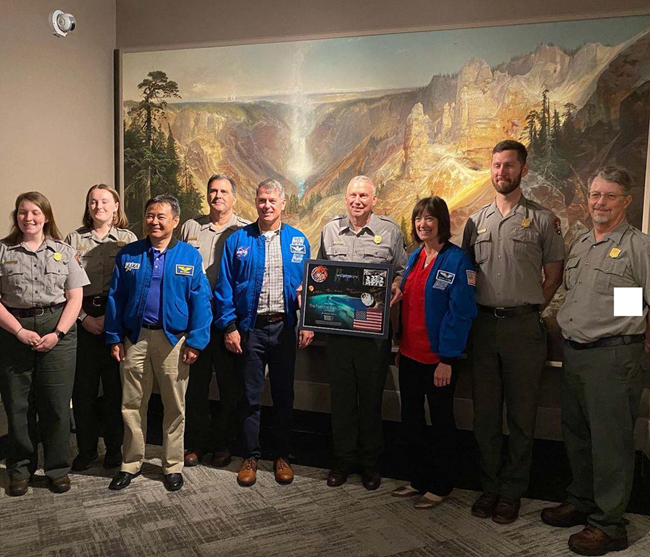Last updated: July 5, 2022
Article
Astronauts Visit National Park Service Headquarters

NPS Photo
On June 9, 2022, members of the National Aeronautics and Space Administration’s (NASA) SpaceX Crew-2 mission visited National Park Service Headquarters in Washington D.C. for a celebration of science, astronomy, art and exploration.
SpaceX Crew-2 returned to earth last November after a record-setting six months aboard the International Space Station. During their visit to Headquarters, the crew met with park leadership and employees to learn about the National Park Service’s efforts to protect and preserve our dark skies.
Assistant Secretary for Fish and Wildlife and Parks Shannon Estenoz and several park rangers greeted SpaceX Crew-2 members Megan McArthur, Shane Kimbrough, and Aki Hoshide at the Stewart Lee Udall Department of the Interior Building.
Dozens of Department of the Interior employees were on hand for the event including Grand Canyon National Park Ranger Rader Lane. Grand Canyon hosts one of the premier night sky festivals in the National Park Service. He moderated the meeting and spoke passionately about the importance of night skies in our national parks.
SpaceX Crew-2 returned to earth last November after a record-setting six months aboard the International Space Station. During their visit to Headquarters, the crew met with park leadership and employees to learn about the National Park Service’s efforts to protect and preserve our dark skies.
Assistant Secretary for Fish and Wildlife and Parks Shannon Estenoz and several park rangers greeted SpaceX Crew-2 members Megan McArthur, Shane Kimbrough, and Aki Hoshide at the Stewart Lee Udall Department of the Interior Building.
Dozens of Department of the Interior employees were on hand for the event including Grand Canyon National Park Ranger Rader Lane. Grand Canyon hosts one of the premier night sky festivals in the National Park Service. He moderated the meeting and spoke passionately about the importance of night skies in our national parks.

NASA photo

NPS Photo
Ranger Lane provided some closing remarks for the astronauts visit, "We thank NASA and SpaceX Crew-2 for their continued exploration of space and for their dedication to our public lands on Earth. Their visit comes at a pivotal moment in our history—for in no time in human history have we had so much collective knowledge about the stars, so much understanding of our shared universal need for the skies, so much mythology, history, and science written into the firmament—yet paradoxically, at no time in human history have we been so utterly veiled from the night. We are one of the first few generations who have the opportunity to couple the divine aesthetics of the celestial sphere together with the knowledge of its awesome extent, yet we are also the first to live in a world where 80% of people in the United States can no longer see the Milky Way from their homes due to light pollution. It has been fortuitous that national parks and other public lands have become the last remaining sanctuaries of pristine natural darkness. The National Park Service is honored to be entrusted with the protection of resources like our night skies, and inspired to continue onward in their preservation, especially when those scientists, explorers, and artists, brave enough to venture into space, return only to reaffirm the hallowed ground of our national parks, and to show us glimpses of what potentials lie before us over the new horizon."
Tags
- nasa
- night skies
- international space station
- department of interior
- assistant secretary of fish and wildlife and parks
- shannon estenoz
- shawn benge
- grand canyon national park
- thomas moran
- grand chasm of the colorado
- dark skies
- astronomy
- space
- stars
- astronauts
- spacex crew-2
- megan mcarthur
- shane kimbrough
- aki hoshide
- rader lane
